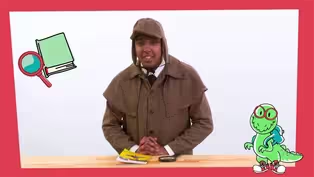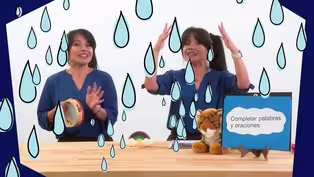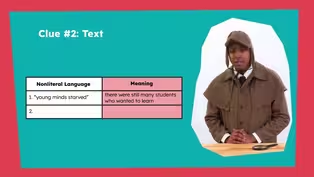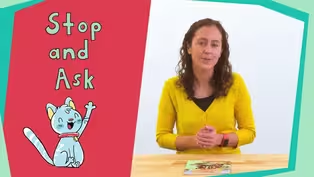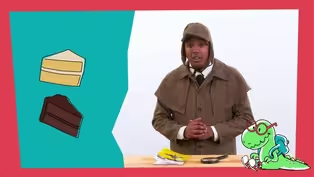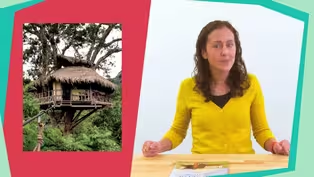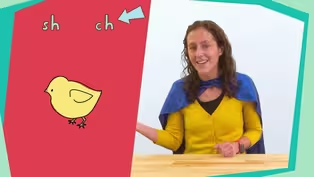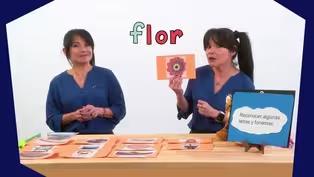
Episode 43 | Literacy Lessons
5/11/2021 | 28m 45sVideo has Closed Captions
LIteracy lessons for early learners, led by NC teachers.
In the first lesson (aimed at PreK-K) students will learn to recognize six commonly-used high-frequency words. The second lesson (aimed at 1st-2nd graders) teaches learners about R-controlled vowels. Classroom Connection is your At-Home Learning companion where children love to learn. All lessons are led by NC educators.
Problems playing video? | Closed Captioning Feedback
Problems playing video? | Closed Captioning Feedback
At-Home Learning Presents: Classroom Connection is a local public television program presented by PBS NC

Episode 43 | Literacy Lessons
5/11/2021 | 28m 45sVideo has Closed Captions
In the first lesson (aimed at PreK-K) students will learn to recognize six commonly-used high-frequency words. The second lesson (aimed at 1st-2nd graders) teaches learners about R-controlled vowels. Classroom Connection is your At-Home Learning companion where children love to learn. All lessons are led by NC educators.
Problems playing video? | Closed Captioning Feedback
How to Watch At-Home Learning Presents: Classroom Connection
At-Home Learning Presents: Classroom Connection is available to stream on pbs.org and the free PBS App, available on iPhone, Apple TV, Android TV, Android smartphones, Amazon Fire TV, Amazon Fire Tablet, Roku, Samsung Smart TV, and Vizio.
Providing Support for PBS.org
Learn Moreabout PBS online sponsorshipMore from This Collection
Video has Closed Captions
Literacy lessons for early learners, led by NC teachers. (28m 46s)
Video has Closed Captions
Literacy lessons for early learners, led by NC teachers. (28m 46s)
Video has Closed Captions
Literacy lessons for early learners, led by NC teachers. (28m 45s)
Video has Closed Captions
Literacy lessons for early learners, led by NC teachers. (28m 45s)
Video has Closed Captions
Literacy lessons for early learners, led by NC teachers. (28m 46s)
Video has Closed Captions
Literacy lessons for early learners, led by NC teachers. (28m 46s)
Video has Closed Captions
Literacy lessons for early learners, led by NC teachers. (28m 45s)
Video has Closed Captions
Short Description: Literacy lessons for early learners, led by NC teachers. (28m 45s)
Video has Closed Captions
Literacy lessons for early learners, led by NC teachers. (28m 45s)
Video has Closed Captions
Literacy lessons for early learners, led by NC teachers. (28m 45s)
Video has Closed Captions
Literacy lessons for early learners, led by NC teachers. (28m 45s)
Video has Closed Captions
Literacy lessons for early learners, led by NC teachers. (28m 45s)
Providing Support for PBS.org
Learn Moreabout PBS online sponsorship[cheerful upbeat music] ♪ - I just learned that a bolt of lightning is five times hotter than the sun.
Hoo!
That's hot.
How did I learn that?
Reading.
We're gonna get into our literacy lesson right now so we can practice our reading.
Here we go.
[pleasant music] - Hello, super learners, my name is Mrs. Kellogg, and I am so excited to be here with you today.
For today's activity, you will need paper and pencil and a stuffed animal friend.
Ask a trusted adult to help you find these items.
While you are getting your materials ready, I am going to go get mine.
I'll be right back.
[upbeat music] Today I'm going to be reading a book to you titled "My Cat".
Do any of you have a pet cat or kitten at home?
[cats meowing] Give me a thumbs up if you have a pet cat or kitten.
Give me two thumbs up if you would like to have a pet cat or kitten.
Well, I do have a pet cat at home.
Her name is Muffins.
Muffins is a real cat, but this book is a fictional story.
That means it is a story that the author made up.
Before we begin reading, let's take a look at the front cover of our book.
On the front cover of the book, I see a little girl with a black and white cat.
They must be the characters in the book.
The characters of a book are who the story is about.
Now the title or name of this book is "My Cat" Tell your stuffed animal friend the title of the book.
I wonder if this cat belongs to this little girl.
Tell your stuffy what you think.
I think we will find out.
Let's now take a look at what is around the little girl and the cat.
I see green grass, bushes covered with flowers, a brown wooden fence, and a blue sky filled with clouds.
Do you think they are inside or outside?
Tell your stuffed animal friend.
Yes, I agree that they are outside because all of those things are outside things.
We call where this story takes place the setting of the story.
I wonder if this whole book will take place outside.
Let's take a look and see if we can find out.
We are going to read this book together.
in order to read this book, you're going to need to know a few words.
The first word is my.
We can use our letter sounds to read and spell some of the letters in my, and the other sounds we learn by heart.
My has two sounds, mm, eye.
Say those sounds with me.
Mm, eye.
The first sound, mm, is spelled with the letter M. Tell your friend the letter for mm.
That's right, M. We can read these parts using what we know about sounds.
The next sound, eye, is spelled with the letter Y.
Tell your friend the letter for eye.
That's right, Y.
This is the part we have to learn by heart.
Let's spell my together.
M-Y.
What word?
My.
Our second word is likes.
We can use our letter sounds to read and spell some of the letters in likes, and the other sounds we learn by heart.
Likes has four sounds.
Ll, eye, k, ss.
Say those sounds with me.
Ll, eye, k, ss.
The first sound, ll, is spelled with letter L. Tell your friend the letter for ll.
That's right, L. The sound, k, is spelled with letter K. Tell your friend the letter for k. That's right, K. And the last sound, ss, is spelled with the letter S. Tell your friend the letter for ss.
That's right, S. We can read these parts using what we know about sounds.
Now this part we learn by heart.
The sound eye is spelled with these two letters, I and E. Tell your friend the letter for eye.
That's right, I and E. The I and the E is the part we have to learn by heart.
Let's spell likes together.
L-I-K-E-S. What word?
Likes.
Our third word is to.
We can use our letter sounds to read and spell some of the letters in to, and the other sounds we learn by heart.
To has two sounds, t, ooh.
Say those sounds with me.
T, ooh.
The first sound, t, is spelled with the letter T. Tell your friend the letter for t. That's right, T. We can read this part using what we know about sounds.
The next sound, ooh, is spelled with the letter O.
Tell your friend the letter for ooh.
That's right, O.
This is the part we have to learn by heart.
Let's spell to together.
T, O.
What word?
To.
Our last word is the.
We can use our letter sounds to read and spell some of the letters in the, and the other sounds we learn by heart.
The has two sounds, th, uh.
Say those sounds with me.
Th, uh.
The first sound, th, is spelled with the letters T-H. Tell your friend the letters for th.
That's right, T-H. We can read this part using what we know about sounds.
The next sound, uh, is spelled with the letter E. Tell your friend the letter for uh.
That's right, E. This is the part we have to learn by heart.
Let's spell the together.
T-H-E. What word?
The.
Let's review our words.
My.
Likes.
To.
The.
There are more words that we will need to know in order to read these sentences, but I am going to help you figure out what these words say by sounding out the words.
Let's start by reading the title of the book.
"My Cat".
Now you say it.
Read the title to your stuffed animal friend.
Good reading.
Let's turn to the first page.
Do you see any of the words that we just learned?
I see my, likes, to, the.
Now you tell the words to your stuffed animal friend as I point at them again.
Good remembering, super learners.
Now we will read this sentence.
We just learned this word.
Tell your stuffy, my.
We can also use the sounds we know to read the words.
Look at this word, C-A-T.
The first sound is k, the next sound is ah, and then t. And then I'm gonna sound it out and then you will do it with me.
Here I go.
K, at.
Sound it out with me.
K, at.
Now tell your animal friend.
K, at.
Let's say that word faster, cat.
Tell your animal friend, cat.
Great job reading cat.
Here's our next word.
We learned this word earlier.
Likes.
Tell your stuffy, likes.
Here's our next word.
We learned this word already, to.
Tell your stuffed animal friend, to.
Look at the next word.
R-U-N.
The first sound is rr, un.
I'm going to say it out first and then you will do it with me.
Here I go.
Run.
Sound it out with me.
Run.
Now tell your animal friend.
Run.
Let's say that word faster.
Run.
Tell your animal friend, run.
Yes, run.
The very next word is a little short word made of two letters.
We can sound this word out.
On, on.
Sound it out with me.
On, on.
Tell your stuffy.
On, on.
We learned this word before, the.
Tell your stuffed animal friend, the.
Here's our last word.
G-R-A-S-S.
The first sound is g, rr, ah, ss.
I'm going to sound it out and then you will do it with me.
Here I go.
Grass.
Sound it out with me.
Grass.
Now tell your animal friend.
Grass.
Let's say that word faster.
Grass.
Tell your animal friend, grass.
Yes, grass.
Oh, that was amazing decoding.
But now we need to put those words together.
I'll read the sentence, then you read it with me and then you read it to your stuffy.
Here I go.
My cat likes to run on the grass.
Read it with me.
My cat likes to run on the grass.
Read it to your stuffy.
Wow, super learners.
You read a long sentence.
My cat likes to run on the grass.
Now let's turn the page.
The first part of the sentence is the same as the last page.
Let's read it together to your stuffed animal friend.
My cat likes to run.
Here's the next word, U-P.
The first sound is uh, p. I'm going to sound it out first and then you will do it with me.
Here I go.
Up.
Sound it out with me.
Up.
Now tell your animal friend.
Up.
Say that word faster.
Up.
Tell your animal friend.
Up.
You got it.
Up!
We learned this next word already.
Tell your stuffed animal friend.
The.
Our last word is T-R-E-E.
This sound is t, rr, ee.
I'm going to sound it out first, then you will do it with me, tree.
Tell your animal friend.
Tree.
Let's say the word faster.
Tree.
Tell your stuffy, tree.
Way to go.
Now let's put the words in the sentence together.
I will read and you read to your stuffed animal friend.
My cat likes to run up the tree.
Excellent reading, super learners.
Let's turn the page.
Now I can see that almost all of this sentence is the same as the sentence we just read.
This part of the sentence says, "My cat likes to run up the" and then instead of the word tree, which is spelled T-R-E-E, we have a word that starts with H, and then I see I-L-L.
I can sound this word out.
This word says h, ill. Hill.
So this sentence says, "My cat likes to run up the hill."
Here's the cat running up the hill.
Try reading this sentence at home to your stuffed animal friend.
Watch me as I turn the last page in the book.
It starts, "My cat likes to," and then I see a new word.
This word tells us what the cat is doing now.
And it begins with ss.
Let's sound it out.
Ss, leap.
Sound it out with me.
Ss, leap.
Now, say it faster.
Do you know what it is?
Tell your stuffed animal friend.
That's right, sleep.
This word says sleep.
So we can read, "My cat likes to sleep."
And then I see more words we know, on my.
And then I see the letters L-A-P. Let's sound it out.
Ll, ap, lap.
Lap!
If you are sitting down, then you have a lap.
So altogether, this sentence says, "My cat likes to sleep on my lap."
Try reading it faster to your stuffed animal friend so we can sound like expert readers.
My cat likes to sleep on my lap.
Excellent work, super learners.
So today we had a chance to read a book about a little girl and her cat using some words we know and by sounding out some unknown words.
I hope that all of you get to spend some time with your pets today, if you have one.
Have a great day.
- Do you ever feel like a superhero when you learn something new?
Maybe it's just me then, but I feel like I could do anything when I learn new things.
It's so great to be able to learn with you today.
- Hi, I'm Hayden.
- And I'm Kira.
- [Both] And today we're going to be reading "Miss Mary Mack".
[cheerful jazz music] ♪ Miss Mary Mack, Mack, Mack ♪ ♪ all dressed in black, black, black ♪ ♪ With silver buttons, buttons, buttons ♪ ♪ All down her back, back back ♪ ♪ She asked her mother, mother, mother ♪ ♪ For 50 cents, cents, cents ♪ ♪ To see the elephant, elephant, elephant ♪ ♪ Jump the fence, fence, fence ♪ ♪ He jumped so high, high, high ♪ ♪ He reached the sky, sky, sky ♪ ♪ And didn't come back, back, back ♪ ♪ Till the 4th of July, July, July ♪ ♪ He fell so fast, fast, fast ♪ ♪ He fell so hard, hard, hard ♪ ♪ He made a hole, hole, hole ♪ ♪ In her backyard, yard, yard ♪ ♪ The ketchup splashed, splashed, splashed ♪ ♪ The soda popped, popped, popped ♪ ♪ The people screamed, screamed, screamed ♪ ♪ The picnic stopped, stopped, stopped ♪ ♪ He landed with, with, with ♪ ♪ A bumpy thud, thud, thud ♪ ♪ And got all full, full, full ♪ ♪ Of muck and mud, mud, mud ♪ ♪ Miss Mary Mack, Mack, Mack ♪ ♪ Gave him a drink, drink, drink, ♪ ♪ And got him clean, clean, clean, ♪ ♪ Quick as a wink, wink, wink ♪ ♪ His keeper came, came, came ♪ ♪ To take him back, back, back, ♪ ♪ Oh please don't go, go, go ♪ ♪ Cried Mary Mack, Mack, Mack ♪ ♪ I'll feed you hay, hay, hay ♪ ♪ And peanut tea, tea, tea ♪ ♪ If you will stay, stay, stay ♪ ♪ And live with me, me, me, ♪ ♪ The silver buttons, buttons, buttons ♪ ♪ Down my dress, dress, dress ♪ ♪ Will all be yours, yours, yours ♪ ♪ If you say yes, yes, yes ♪ ♪ Now Mary Mack, Mack, Mack ♪ ♪ All dressed in black, black, black ♪ ♪ Has purple button buttons, buttons, buttons ♪ ♪ Down her back, back, back ♪ ♪ And elephant, phant, phant ♪ ♪ Has shiny rows, rows, rows ♪ ♪ Of silver buttons, buttons, buttons, ♪ ♪ Down his nose, nose, nose ♪ ♪ And every day, day, day ♪ ♪ For 50 cents, cents, cents ♪ ♪ They both go out, out, out ♪ ♪ And jump the fence, fence, fence ♪ [cheerful jazz music] - Ta da!
[audience clapping] - [Listener] Wow, good job!
[cheerful jazz music] - I talk all the time about how important our brains are.
But check this out.
Only half of a dolphin's brain goes to sleep when they're sleeping and the other half stays awake.
Maybe that's so they can swim away real quickly if they get into trouble.
I bet your brain is always active, especially during this literacy lesson we're about to get into.
Here it is.
- Hello readers, my name is Ms. Cliette.
I am so excited to be learning with you today.
Before we get started on our lesson, let's say hello with our welcome song.
♪ Hello readers, hello readers ♪ ♪ How are you, how are you ♪ ♪ I'm so glad to see you ♪ ♪ I'm so glad to teach you ♪ ♪ Hello you, you, and you ♪ Very good.
I'm so glad that you came to learn with me today.
Readers, did you know that all letters in the alphabet have special names?
They can be put into two categories, consonants and vowels.
Do you know which letters are the consonants and which letters are the vowels?
There are 21 consonants and five main vowels.
Can you name the letters that are vowels?
If you know them, you can say them along with me.
Ready?
Okay.
A, E, I, O, U.
Do you know the sounds that the vowels A, E, I, O, and U make?
Okay, I'll say them first and then you can say them along with me.
I'm gonna add a few movements with each of the sounds to help us to remember.
Short A says ah.
Short E says eh.
Short I says ih.
Short O says ah.
Short U says uh.
All right.
This time, I want you to say the short vowel sounds with me.
See if you can also do the movements, with each of the sounds.
Ready?
Okay.
Short A says ah.
Short E says eh.
Short I says ih.
Short O says ah.
Short U says uh.
Nice job.
In addition to knowing our letter sounds, during each of the lessons, we are gonna learn words that we call heart words.
Some words contain one or more sounds that are a little bit different than they usually are spelled.
Since these parts are different than usual, we have to learn them by heart.
We can call these words heart words.
To do this, we're going to need to create our very own heart word dictionary.
You will need two pieces of paper and something to write with.
While you go grab your items, I'll go grab mine.
I'll be right back.
[upbeat music] I'm back.
I have my two pieces of paper and something to write with.
I grabbed a marker, but a pen, crayon, or pencil is just fine too.
All right, now let's get to work making our heart word dictionary.
I'm gonna start by stacking my two pieces of paper together and then folding them in half hamburger-style, the short way.
Would you look at that, readers?
It's a book.
Books always have a cover so I'm going to draw a heart and write the word "word" so that I know this is the heart word dictionary.
Today we are going to add two heart words to our heart word dictionary.
Let's discuss the word should, as in, she should hold on tight during the rollercoaster ride.
We can use our letter sounds to spell some of the sounds of should.
The other sounds we have to learn by heart.
Should has three sounds, sh, uh, d. Say those sounds with me.
Sh, uh, d. The first sound, sh, is spelled with the letters S-H. What letters?
That's right, S-H.
The last sound, d, is spelled with the letter D. What letter?
That's right, D. We can read these parts using our phonics knowledge.
The middle sound, uh, is spelled with the letters O-U-L. What letters?
That's right, O-U-L.
This is the part that we have to learn by heart.
Let's spell should together.
S-H-O-U-L-D. What word?
Should.
Now let's write this word down in our heart word dictionary.
S-H-O-U-L-D. Let's discuss the word could, as in, could you please pass the salt?
We can use our letter sounds to spell some of the sounds in the word could, and other sounds we have to learn to spell by heart.
Could has three sounds, k, uh, d. Say those sounds along with me, k, uh, d. The first sound, k, is spelled with the letter C. What letter?
That's right, C. The last sound, d, is spelled with the letter D. What letter?
That's right, D. You can read these parts using your phonics knowledge.
The middle sound, uh, is spelled with the letters O-U-L. What letters?
That's right, O-U-L.
This is the part that you have to learn to spell by heart.
Let's spell could together.
C-O-U-L-D. What word?
Could.
Now let's write this word down in our heart word dictionary.
C-O-U-L-D. Good.
I hope that after this lesson, you'll share your heart word dictionary with someone whom you love.
Together, you can keep adding to your dictionary.
That was a great warmup, readers.
Now we are going to learn about R-controlled vowels, or as I like to call 'em, Bossy R. I can't wait to show you.
Today, we are going to learn about R-controlled vowels.
The letter R is a consonant, and it is very bossy.
When the letter R is behind the vowel, A, E, I, O, U, it changes the sound of the vowel.
Today we will focus on how R bosses around the letter O.
At the beginning of our lesson, we reviewed the sounds of short vowels.
However, when Bossy R is behind those vowels, the sound changes.
Let me demonstrate.
When the letter R is behind the letter A, it no longer says, ah, it now says are, like in the word star.
When the letter R is behind the letter E, it no longer says eh, it now says er, like in the word germ, yuck.
When the letter R is behind the letter I, it no longer says ih, it now says er, like in the word stir.
When the letter R is behind the letter O, it does not say ah anymore.
It now says or, like in the word horn.
Honk honk!
When the letter R is behind the letter U, mm mm, it does not say uh, it now says er, like in the word curl.
Did you hear how Bossy the letter R can be?
The letter R controls the sounds of the vowels that come before it.
And in other words, it bosses it around and changes the sound.
Today we will focus on how R bosses around the letter O.
When the letter R has the letter O in front of it, it most commonly makes the sound or.
Let's see how this works.
I'm going to build a few words.
Let's start with this one.
Do you know what this word is?
I'm gonna tap out the sounds in this word to figure out the word I built.
Remember, O-R makes the or sound.
So these two letters will be blended together to make one sound.
Are you ready?
Okay.
B, or, n. Born.
This word is born.
Can you say born?
Listen to the sound of the O-R in the word born.
Bossy R makes the O in the word say or.
Let's try another one.
What word did I build?
Let's tap out the sounds in this word to figure it out.
F, or, t. Fort.
Good job.
This word is fort.
What sound is O-R making?
You got it.
The O-R is making the or sound.
Let's read these words together.
Ready?
Okay.
Born, fort.
Wow, you did an amazing job tapping out the sounds in each of those words.
You also remember that O-R is read together and it makes the or sound.
O-R is an R-controlled vowel.
Now that we have practice reading O-R words, let's see if you can read a couple of sentences and spot the words that have the R-controlled vowel O-R.
Okay.
Get your reading eyes ready.
Your reading eyes ready.
Let's read the first sentence.
They used the sticks to form the fort.
I see and hear Bossy R bossing around the vowel in front of it.
Do you?
What words had the R-controlled vowel or?
That's right.
Let's underline the words form and fort.
Okay.
Let's read our next sentence.
Kim ate the corn with a fork.
There's Bossy R, bossing around the vowel in front of it.
Do you see it and hear it?
What word had the R-controlled vowel, or?
That's right, corn and fork.
Let's underline them.
Today, you did an amazing job identifying Bossy R words that had the R-controlled vowel O-R.
When you are reading on your own and you come across these words, remember to practice this skill that you learned today to help you to decode those words.
I hope that you had fun today, too.
I'll see you next time, readers.
Bye-bye.
- I can't believe how fast that lesson flew by.
I feel stronger and smarter already.
Can you flex for me?
Yeah!
Awesome.
Our brains are flexing too.
Gotta keep that mind fresh.
[cheerful upbeat music] ♪
Support for PBS provided by:
At-Home Learning Presents: Classroom Connection is a local public television program presented by PBS NC
